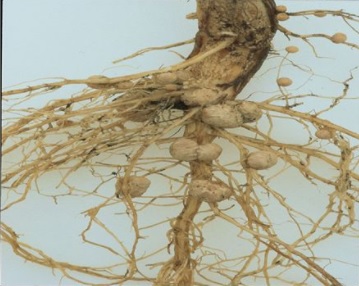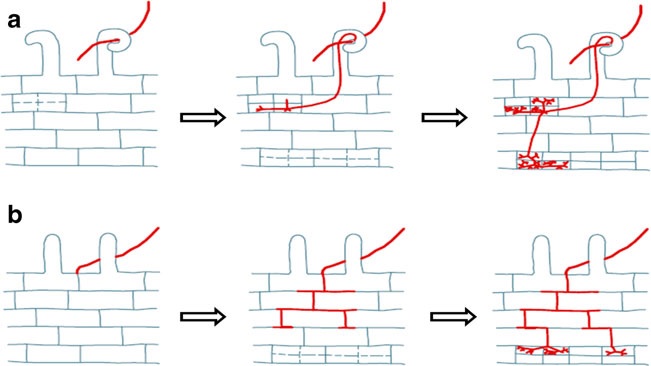Actinorhiza
Definitions
An actinorhiza is referred to as a root nodule formed as a result of a symbiotic relationship between an actinomycete and fine plant roots. [1] To further clarify what an actinorhiza is, refer to the following:
Root Nodule: A small knot or joint on a stem or root, especially one containing nitrogen-fixing bacteria [1]
Symbiotic: A relationship with mutual benefit between two individuals or organisms [1]
Actinomycete: Any of various bacteria (order Actinomycetales) with a branching, filamentous structure [1]
Root Nodules

As stated above, actinorhiza are the small nodules that form on the roots of plants. These nodules produce tangible nitrogen for the plants that they are attached to by pulling in nitrogen that is currently in the atmosphere. These nodules are essential to plant growth, as plants struggle to find sources of nitrogen without them, making it difficult for them to grow and stay alive. However, root nodules are not able to form on every kind of plant. The type of plant that can host the nodules consist mainly of legumes. Other types of plants must rely on other sources of nitrogen, which for crops and other plants grown by farmers, comes from fertilizer. A study done by Horst Rohrig and Richard Walden shows that nodules can be artificially grown on non-leguminous plants. The use of lipo-chitooligosaccharides, or LCOs, shows that non-leguminous plants can undergo the same type of cell division to create nodules on their roots. Although these nodules do not have the same nitrogen fixation ability as the naturally occurring nodules, this study does show that LCOs are a main factor of plant and root nodule growth. [2]
Leguminous plants can obtain root nodules through either legume-rhizobium symbiosis or actinorhiza, which both require a certain symbiosis receptor-kinase gene known as SYMRK in order to perform symbiosis with the plant. These types of root nodules differ based on their bacterial partner, intracellular infection pattern, and morphogenesis. The bacteria that make up the actinorhiza will always stay within the infection threads, which are tubular structures that are surrounded by a host-derived membrane that is continuous with the plasma membrane, and bound by plant cell wall-like material, during the nitrogen fixation process. Meanwhile, legume-rhizobium bacteria can either remain in the infection threads or leave in order to develop into bacteroids. [8]
Frankia
Frankia is a type of actinomycete that forms a symbiotic relationship with plant roots in order to form actinorhiza for nitrogen fixation. To form these symbiotic relationships, the Frankia strain sends out hyphae, which burrow into the roots and reside in between the cell wall structures of the plant cells. [4] These hyphae will typically enter into the roots through the fine hairs coming off of the roots, but in certain situations, the hyphae can go directly into the cells themselves. Once the strain of Frankia enters the root hair, it will begin to make the root hair have deformities. These deformities include curling of the root hair and certain types of branching patterns. It is believed that these deformities allow easier passage of enzymes between the Frankia and the cell walls because the deformities disorganize the cell walls to make them more loosely packed together. This ease of access to the enzymes then allows the Frankia to dive even deeper into the interior of the root hair. From there, the Frankia strain will facilitate the growth of actinorhiza nodules from within the root hairs. [5] However, certain strains of Frankia can only grow in certain habitats. Different strains have been found to grow within different elevations, but there were some strains that were found at multiple elevations. It has been determined that the majority of Frankia strains are found at intermediate elevations, but also with intermediate precipitation, while the lowest number of Frankia strains were found at low elevations, but with high precipitation, and high elevations with low precipitation. Not only that, but Frankia strains have been observed to appear with more genetic diversity in soils that contain higher amounts of vegetation cover due to the enhanced soil fertility and the improved soil physical and chemical properties by root penetration and soil aggregation. It is also assumed that Frankia concentration is affected by other factors such as temperature, soil type, soil moisture, pH, and organic matter content. [7] Since these factors affect the growth of Frankia, it can also be said that these factors influence the growth of actinorhiza as well.

References
[1] "actinorhiza." YourDictionary, n.d. Web. 4 April 2018. <http://www.yourdictionary.com/actinorhiza>.
[2] Adler, Tina. "Getting to the root of nodule formation." Science News, 12 Aug. 1995, p. 102. General OneFile, http://link.galegroup.com/apps/doc/A17198831/GPS?u=avlr&sid=GPS&xid=b3e076c8. Accessed 5 Apr. 2018.
[3] Taylor, Ariel. “Assimilation and Fixation of Nitrogen.” SlidePlayer, Slideplayer.com Inc., 2016, slideplayer.com/slide/7611776/.
[4] Benson, David R., and Warwick B. Silvester. "Biology of Frankia strains, actinomycete symbionts of actinorhizal plants." Microbiological Reviews, vol. 57, no. 2, 1993, p. 293+. General OneFile, http://link.galegroup.com/apps/doc/A14217442/GPS?u=avlr&sid=GPS&xid=c8cc6110. Accessed 7 Apr. 2018.
[5] Peterson, R. Larry, and Melissa L. Farquhar. "Root hairs: specialized tubular cells extending root surfaces." The Botanical Review, vol. 62, no. 1, 1996, p. 1+. General OneFile, http://link.galegroup.com/apps/doc/A18262550/GPS?u=avlr&sid=GPS&xid=224acfbe. Accessed 17 Apr. 2018.
[6] Pawlowski, Katharina, and Kirill N Demchenko. “The Diversity of Actinorhizal Symbiosis.” Research Gate, ResearchGate GmbH, Mar. 2012, www.researchgate.net/publication/221685565_The_diversity_of_actinorhizal_symbiosis.
[7] Chen, Li-hong, et al. "Genetic diversity of Frankia strains in root nodules from Hippophae rhamnoides L." Botany, vol. 86, no. 3, 2008, p. 240+. General OneFile, http://link.galegroup.com/apps/doc/A180664604/GPS?u=avlr&sid=GPS&xid=4d7b03e9. Accessed 17 Apr. 2018.
[8] Markmann, Katharina, et al. "Functional adaptation of a plant receptor-kinase paved the way for the evolution of intracellular root symbioses with bacteria." PLoS Biology, vol. 6, no. 3, 2008, p. 497+. Student Edition, http://link.galegroup.com/apps/doc/A202126568/GPS?u=avlr&sid=GPS&xid=13629742. Accessed 19 Apr. 2018.